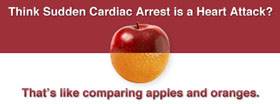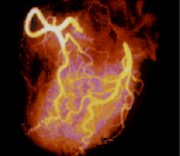|
Sudden cardiac arrest (SCA) is also called sudden cardiac death. Sudden cardiac arrest occurs when the heart suddenly stops beating, which stops oxygen-rich blood from reaching the brain and other organs. A person can die from SCA in minutes if it is not treated right away.
Sudden cardiac arrest is not a heart attack, even though you may hear the terms “heart attack” or “massive heart attack” used to describe it. A heart attack happens when blood flow to a part of the heart is slowed or stopped, usually because of plaque rupture in one of the coronary arteries. This causes death of the heart muscle. But a heart attack does not always mean that the heart stops beating. A heart attack may cause SCA, but the two terms do not mean the same thing.
What causes SCA?
According to the National Heart, Lung, and Blood Institute, between 250,000 and 450,000 Americans have SCA each year. Almost 95% of these people die within minutes.
Sudden cardiac arrest happens most often in adults in their mid 30s to mid 40s. It affects men twice as often as it affects women. It hardly ever affects children, unless they have an inherited problem that increases their risk.
People with heart disease have a greater chance of SCA, but it can happen in people who appear healthy and do not know they have any heart problems.
Most cases of SCA are caused by a very fast heartbeat (ventricular tachycardia) or a very chaotic heartbeat (ventricular fibrillation). These irregular heart rhythms, called arrhythmias, may cause the heart to stop beating. Another type of arrhythmia, called bradycardia, which is a very slow heart rate, can also cause SCA.
Other causes of SCA are
- Coronary artery disease (CAD), which results from a condition called atherosclerosis. Atherosclerosis is a condition where a waxy substance (plaque) forms inside the arteries that supply blood to your heart. If that plaque builds up in the arteries that supply blood to your heart, the blood flow slows or stops. This decreases the amount of oxygen that gets to the heart, which can lead to a heart attack. Any scarring or damage to the heart after a heart attack increases the risk of arrhythmia and SCA.
- Physical stress, which can cause the heart’s electrical system to stop working. In people who already have heart problems, intense physical activity or exercise can lead to SCA because the release of the hormone adrenalin acts as a trigger for SCA.
- Inherited disorders, which are disorders that run in families. Some types of arrhythmias tend to run in families. Also, people born with heart defects, a coronary artery anomaly (CAA), or Brugada Syndrome may be at greater risk of SCA.
- Medicines for heart disease, which can sometimes increase the risk of arrhythmias.
- Illegal or illicit drug use (like cocaine).
- Changes to the size or shape of the heart, which can be caused by high blood pressure or heart disease. Changes to the heart’s structure may cause problems with its electrical system, increasing the risk of arrhythmias.
What are the signs and symptoms of SCA?
For most people, the first sign of SCA is fainting or a loss of consciousness, which happens when the heart stops beating. Breathing may also stop at this time. Some people may experience dizziness or lightheadedness just before they faint.
How is SCA diagnosed?
Because SCA happens quickly and without warning, it usually cannot be diagnosed when it is happening. But there are tests that doctors use to determine if patients are at risk of SCA:
- Electrocardiography (ECG or EKG), which is used to look at the electrical activity of the heart. An electrocardiogram can tell your doctor a lot about your heart and how it is working. This test can help your doctor learn more about your heart rhythm, the size and function of the chambers of your heart, and your heart muscle.
- Echocardiography, which uses sound waves to produce an image of the heart to see how it is working.
- Cardiac catheterization, which involves threading a long, thin tube (called a catheter) through an artery or vein in the leg or arm and into the heart. Depending on the type of test your doctor has ordered, different things may happen during cardiac catheterization. For example, a dye may be injected through the catheter to see the heart and its arteries (a test called coronary angiography or coronary arteriography).
- Electrophysiology studies (EPS), which use cardiac catheterization techniques to study patients with arrhythmias. EPS shows how the heart reacts to controlled electrical signals.
- Gated blood pool scan, or MUGA, which shows how well your heart is pumping blood.
- Magnetic resonance imaging (MRI) which gives doctors detailed pictures of your heart.
How is SCA treated?
Sudden cardiac arrest should be treated right away with a defibrillator, which is a device that sends an electrical shock to the heart to restore its normal rhythm. If you think someone is having SCA, you should dial 9-1-1 right away.
Defibrillators are now available in many public places, such as shopping malls and airports. But if someone is having SCA and there is no defibrillator available, then cardiopulmonary resuscitation (CPR) should be performed until an ambulance or other help arrives. The chest compressions given during CPR move a small amount of blood to the heart and brain, “buying time” until a normal heartbeat can be restored. Patients with known heart problems who are at risk of SCA should be under the care of a doctor.
Patients who have already had SCA are at greater risk of having it again. These patients may be treated with antiarrhythmic medicines or an implantable cardioverter defibrillator (ICD) to stop the arrhythmias that can lead to SCA. An ICD is a device that applies electric impulses or, if needed, a shock to restore a normal heartbeat.
In some patients, balloon angioplasty or coronary artery bypass surgery may be performed to treat their CAD and prevent the heart damage that can lead to arrhythmias and SCA.
See also on this site: Center for Coronary Artery Anomalies

See on other sites:
 American Heart Association American Heart Association
http://cpr.heart.org/AHAECC/CPRAndECC/Programs/HandsOnlyCPR/UCM_473196_Hands-Only-CPR.jsp
Learn Hands-Only™ CPR with this video from AHA.

Heart Rhythm Society
www.hrsonline.org/News/Sudden-Cardiac-Arrest-SCA-Awareness
Sudden Cardiac Arrest (SCA) Awareness
MedlinePlus
https://medlineplus.gov/cardiacarrest.html
Cardiac Arrest
Updated August 2016
|



